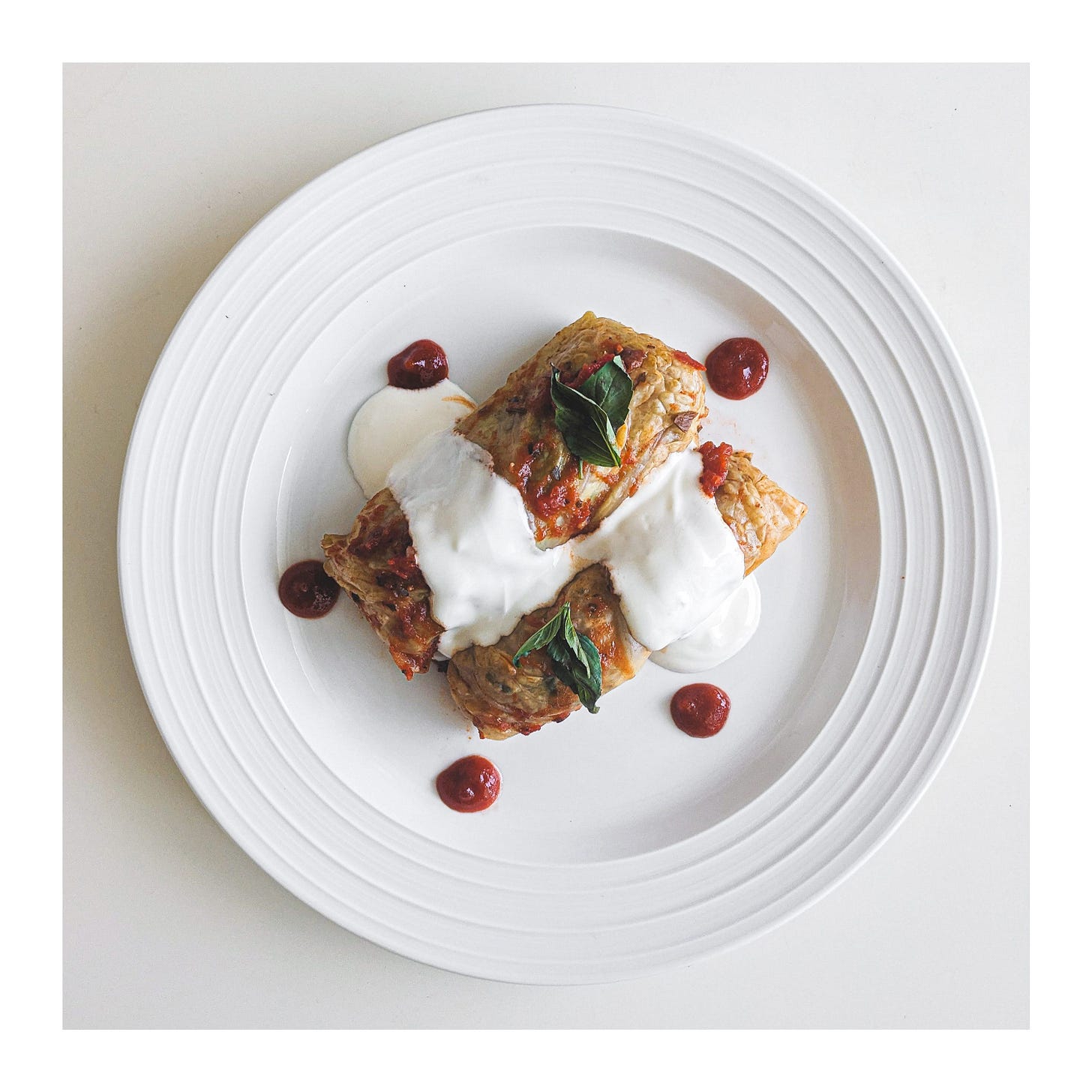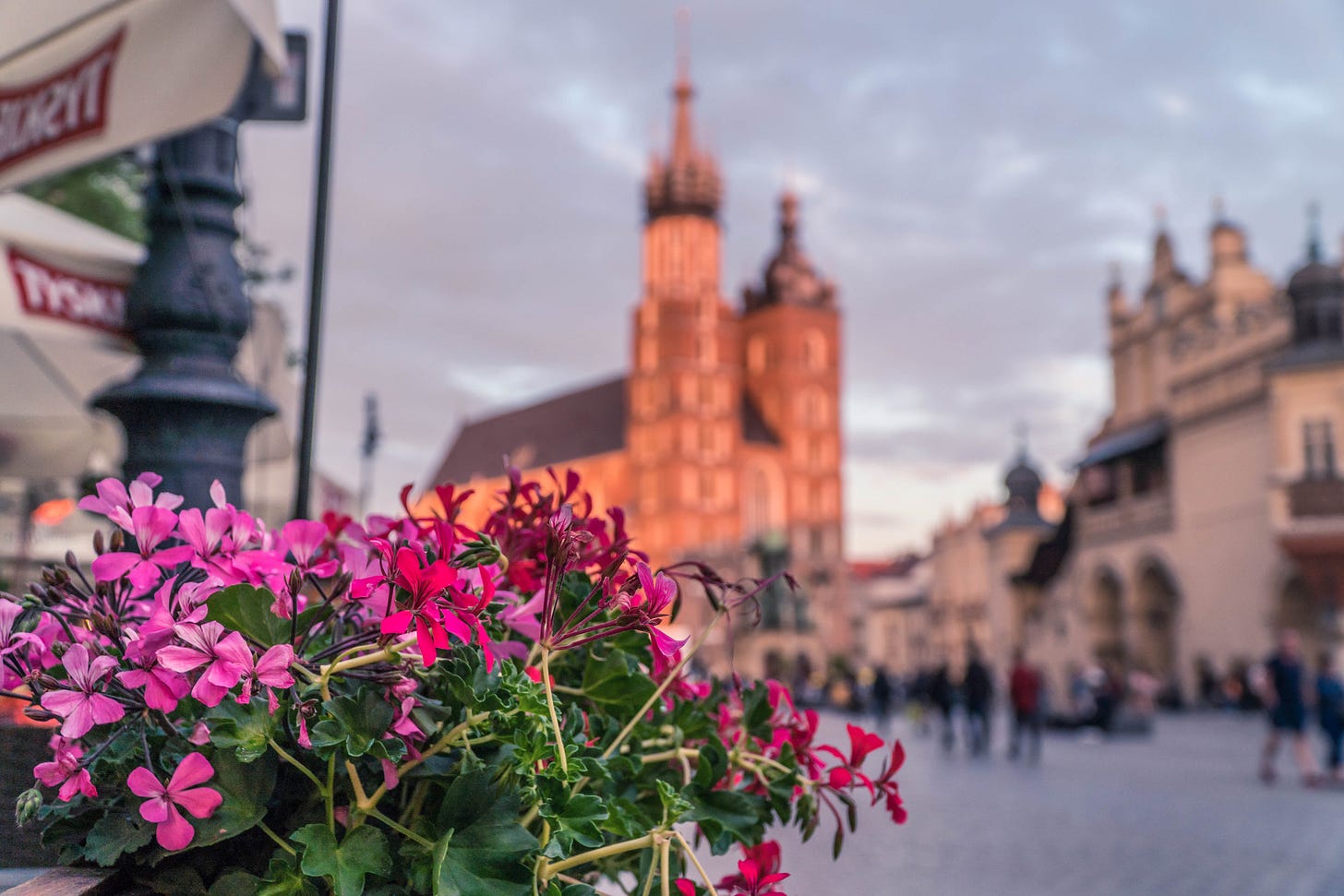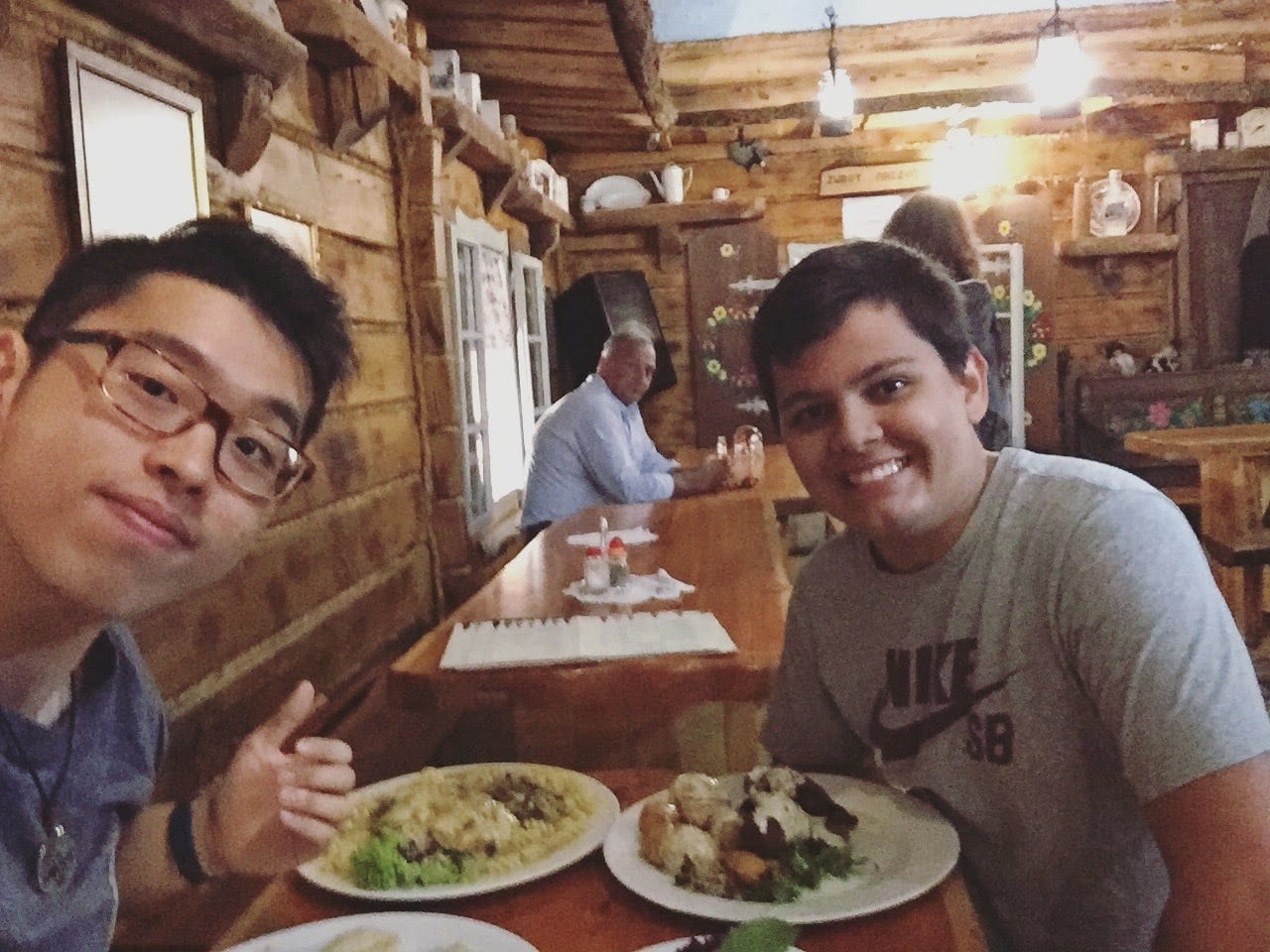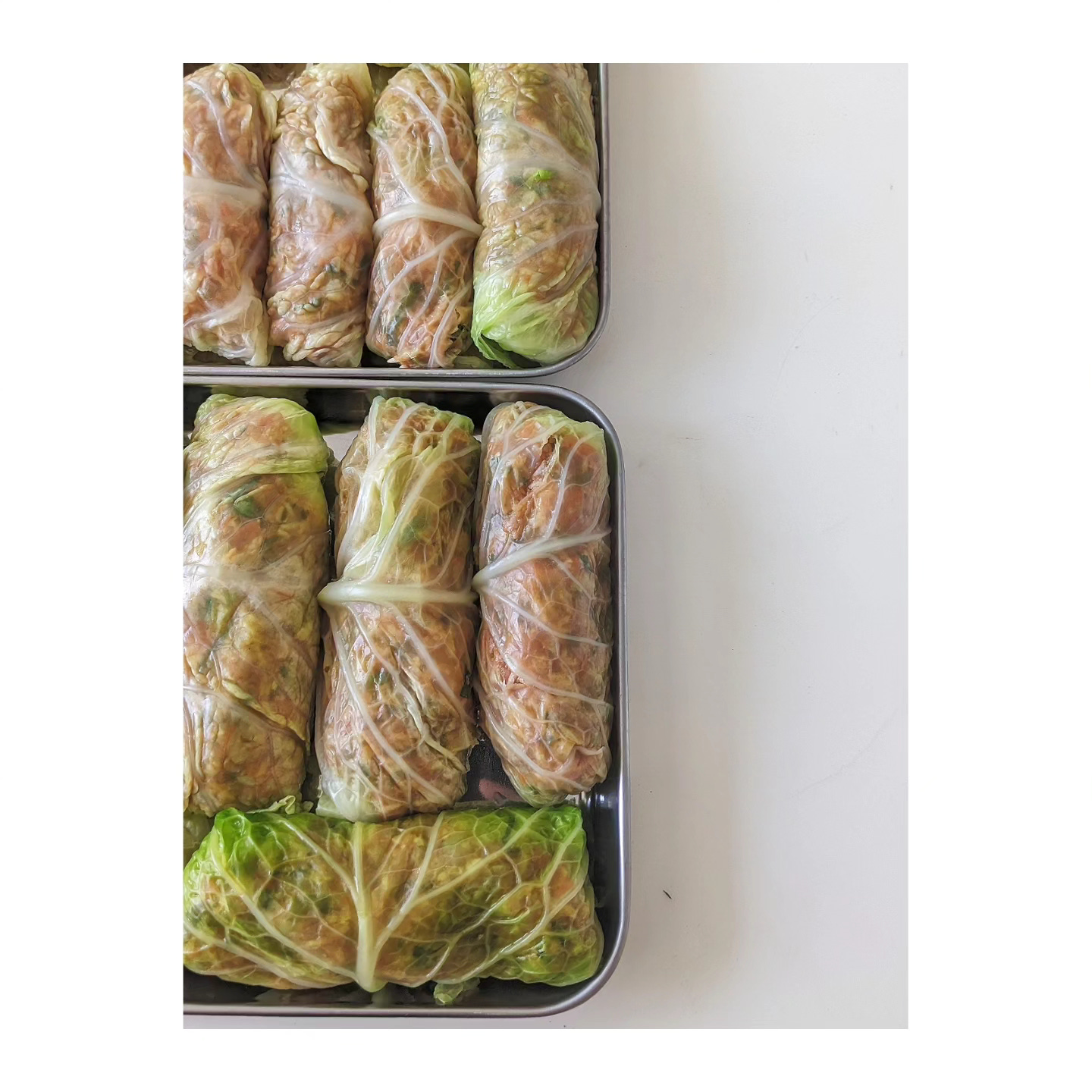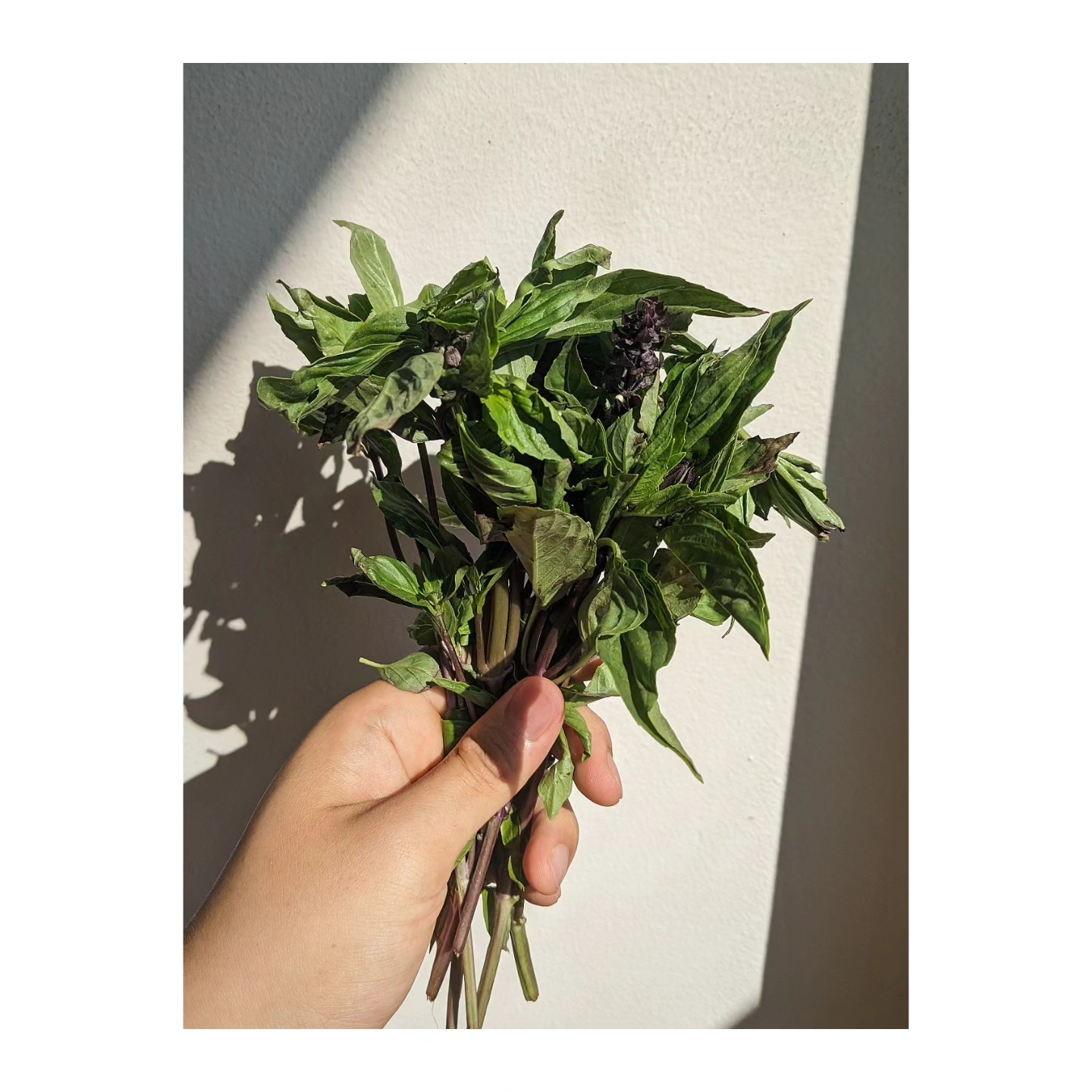My Story with Polish Cabbage Roll
I first tasted the Polish cabbage roll (Gołąbki) in the summer of 2017 during an internship in Eastern Europe. My friend Gabriel and I took an overnight bus from Budapest to Kraków through the mountainous region of Slovakia. The bumpy bus ride, paired with little sleep and a long conversation with my neighbour, made me feel blessed and slightly delusional when we reached Poland at dawn. Roaming around the empty piazza with the first sun rays shining through the church bell had me questioning if I was awake or dreaming about this sight.
^Heartwarming interaction between a musician and a little girl
^ Sunset in Kraków
That evening, we consulted with our hostel staff to find the best homey Polish restaurant and found ourselves walking through the narrow alleys of the old town to this tiny storefront outside the tourist district. With no English words on the exterior design and no server trying to sit us down, we carefully peeked our heads through the heavy and dark curtains.
I've never been to a traditional Polish grandma's home, but somehow, that restaurant was exactly how I imagined it would look. As we walked down a few stairs, this warm hue from the ceiling lights opened us up to the restaurant's main floor. The walls were covered in old newspapers and magazines with children's dolls and random small home appliances stashed in every corner of the room. The restaurant owner saw us two knuckleheads, warmly welcomed us, and sat us down by the bar. Despite the language barrier and the lack of English-translated menus, we used our broken Polish and Google Translate to order cabbage rolls, perogies, and fried Polish pork chops for the table.
^ Found this gem of a photo of me and Gabriel, dining in that exact restaurant in 2017
My first bite of the cabbage roll did not blow my pants off. But, as I took the second and third bite, the smokiness of the paprika, the freshness of dill paired with the cold, tangy and creamy sour cream started to create this symphony in my mouth with the savoury filling and the sweet & tender cabbage. Long story short, I did not talk to my friend until I finished every drop of that dish haha.
Since then, I have been chasing the dragon on this dish and never found the opportunity to recreate it at home until this past fall.
History of Gołąbki
When a dish is exceptionally tasty, the word "traditional" often appears in its recipe. That sort of terminology has great power because it can create some disagreement and competition among neighbouring cultures who want to claim its authorship. In the case of cabbage rolls, the "production" of the dish may differ in ingredients among different cultures. Still, their delicious taste and uncomplicated cooking process can make any country that features them in its cuisine want to have them exclusively. So, who do we have to thank for the famous stuffed cabbage rolls? Credit is believed to be owed to the poorer inhabitants of Central and Eastern European countries. Due to the widespread cultivation of cabbage in these regions, the cultures who inhabited them are likely the original “inventors” of this favourite dish. Though the production of the stuffed cabbage roll is very similar from culture to culture, the ingredients of the stuffing and the variety of cabbage leaves used can vary.
The history of Polish gołąbki begins in the nineteenth century with the arrival of Ukrainian “hołubci.” The Ukrainian name probably comes from the fact that in Slavic languages, the names of animals and birds were often used to name breads and ritual dishes. The borderland dish was so well received by Poles that it soon settled in Polish cuisine for good. Today, Poles mention “gołąbki” in one breath, next to bigos, pierogi and red borscht, as a traditional national dish enjoyed for special occasions and everyday dinners.
Poland’s gołąbki were originally stuffed with a blend of buckwheat and potatoes but modern versions can include rice and mushroom, grains & forest mushroom or ground meat. They are baked or simmered in a flavorful broth and typically topped with a creamy mushroom or tomato sauce.
Recipe (it’s terrifying to share recipes online…)
Ingredients
1 head of green cabbage ( I prefer savoy cabbage for a sweeter and textured leaf)
1 pound lean ground beef
1/2 pound ground pork
2 large eggs
1 yellow onion (finely chopped)
1 stalk of leek (finely chopped)
8 cloves of garlic (minced)
1 large carrot (finely chopped)
2 cups Basil (I used Thai basil)
28 ounces crushed tomatoes
1 1/2 cups of uncooked rice
1 tablespoon butter
2 tablespoons garlic chilli oil OR olive oil (optional, lmk if you would like to learn about the recipe:D)
1 1/2 cups of water
Salt & pepper to taste (I would love to get into more of my cooking philosophy and framework in the future)
1/4 cup sour cream (for garnish)
Chopped fresh dill (optional for garnish)
Instruction
Remove the stalk from the bottom of the cabbage head.
Place the cabbage in a large pot filled with 12 cups of salted water. Cover and place over high heat.
Bring to a boil and then reduce the heat to medium. Cook until the cabbage leaves become bright green and pliable, about 3-5 minutes. The leaves should not be limp; they should hold their shape.
Remove the cabbage from the water and let it cool on a cutting board.
Sautee onion, garlic, leeks, and carrots in butter and chilli oil until softened and caramelized. Season the aromatics to taste with salt and pepper.
In a large bowl, combine ground beef, pork, sauteed aromatics, basil, eggs, 1 cup of tomato sauce and rice. Place in refrigerator until ready to use.
In a medium pot over medium heat add oil. Once simmering, stir in grated onion and cook, stirring frequently, for 2 minutes. Then, add garlic and cook until fragrant, about 30-60 seconds. Pour in crushed tomatoes, water, salt, and pepper and increase heat to high. Once bubbling, reduce heat to low and simmer tomatoes for 15 minutes.
Once the cabbage has cooled, remove the leaves from the cabbage head. Using a paring knife, cut the thick stem or membrane from the back of each leaf. Be careful not to cut through the leaf.
Move oven racks to upper-middle and lower-middle positions. Preheat oven to 350-375 degrees F.
You will need a 9x13-inch baking dish or a deep crock pot for this recipe. Spread ¾ cup of sauce in the bottom of a baking dish or crock pot.
Place 2 tablespoons of filling on the bottom half of a cabbage leaf. Fold up the bottom part of the cabbage leaf. Then, fold in the sides. Next, roll forward until the cabbage leaf completely covers the filling. Repeat with remaining cabbage leaves and filling. —> Here is a video of me rolling the cabbage for the demo.
Place the stuffed cabbage leaves into prepared pans in neat rows. Pour the remaining sauce evenly over the rolls.
Bake for 90 minutes to 2 hours, rotating pans halfway through. Let it cool for 15 minutes before serving.
Meanwhile, whip the sour cream till loose and fluffy and serve it on top of the plated cabbage rolls with chopped dill and hot sauce.
- JC




